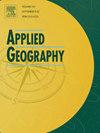Excess mortality, COVID deaths, and spatial accessibility to health care services in the conterminous United States
IF 5.4
2区 地球科学
Q1 GEOGRAPHY
引用次数: 0
Abstract
Since the onset of COVID 19, the pandemic has put extra burden on mortality in the United States. This study aims to investigate the regional variations of death rates and the associations between excess deaths and the underlying population characteristic and spatial access to medical services during the pandemic. To this end, this study estimated the excess deaths in 2020 and the travel times to the nearest healthcare facilities, PCP ratios, and medical facility to population ratios at the county level in the conterminous United States. Coupling the death data with population characteristics, socio-economic factors, health factors and access to healthcare facilities, this study employed spatial statistical methods, including global and local spatial autocorrelation analyses, bivariate spatial analysis and geographically weighted generalized linear regression to investigate their relationships. The results revealed that the impact of COVID varied across the country. The South, particularly the Deep South, was hit the hardest. Compared to the spatially varying relationship between COVID deaths, unemployment, minority, smoking rates and excess deaths, poverty was the primary factor linked to excess deaths nationally. While the access to healthcare services was not associated with excess deaths in general, it did vary significantly between counties with high/low death rates.
美国相邻地区的高死亡率、COVID死亡和卫生保健服务的空间可及性
自2019冠状病毒病(COVID - 19)发生以来,大流行给美国的死亡率带来了额外的负担。本研究旨在调查大流行期间死亡率的区域差异以及超额死亡与潜在人口特征和获得医疗服务的空间可及性之间的关系。为此,本研究估计了2020年的超额死亡人数以及到最近的医疗机构的旅行时间、PCP比率以及美国相邻县一级医疗机构与人口的比率。本研究将死亡数据与人口特征、社会经济因素、健康因素和医疗设施可及性等因素进行耦合,采用空间统计方法,包括全局和局部空间自相关分析、双变量空间分析和地理加权广义线性回归等,探讨了它们之间的关系。结果显示,新冠肺炎的影响在全国各地有所不同。南方,尤其是南方腹地,受到的打击最为严重。与COVID死亡、失业率、少数民族、吸烟率和超额死亡之间的空间差异关系相比,贫困是与全国超额死亡相关的主要因素。虽然一般而言,获得保健服务与超额死亡无关,但死亡率高/低的县之间确实存在显著差异。
本文章由计算机程序翻译,如有差异,请以英文原文为准。
求助全文
约1分钟内获得全文
求助全文
来源期刊

Applied Geography
GEOGRAPHY-
CiteScore
8.00
自引率
2.00%
发文量
134
期刊介绍:
Applied Geography is a journal devoted to the publication of research which utilizes geographic approaches (human, physical, nature-society and GIScience) to resolve human problems that have a spatial dimension. These problems may be related to the assessment, management and allocation of the world physical and/or human resources. The underlying rationale of the journal is that only through a clear understanding of the relevant societal, physical, and coupled natural-humans systems can we resolve such problems. Papers are invited on any theme involving the application of geographical theory and methodology in the resolution of human problems.
 求助内容:
求助内容: 应助结果提醒方式:
应助结果提醒方式:


